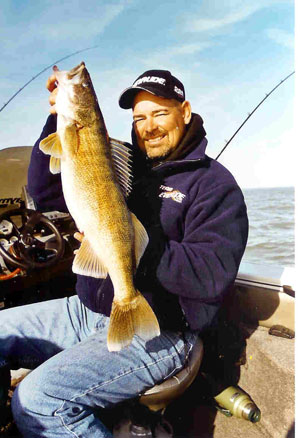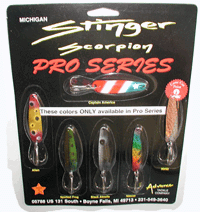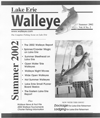|
Up Front for Big
Walleyes
By Rick Olson
Cold fronts come and go and often take with
them the hopes and dreams of anglers
 looking
for the mother of all walleye loads. They’re often associated with some of
the toughest conditions you may be faced with and rightly so, but the news
in not all bad. In fact there can be some real good hiding behind all of
the bad; you just have to know where to look. Understanding how a cold
front can effect location and attitude is the first big step in putting the
walleye puzzle together. looking
for the mother of all walleye loads. They’re often associated with some of
the toughest conditions you may be faced with and rightly so, but the news
in not all bad. In fact there can be some real good hiding behind all of
the bad; you just have to know where to look. Understanding how a cold
front can effect location and attitude is the first big step in putting the
walleye puzzle together.
The effects of a front can be broken down
into three parts and includes the approach, the middle or actual passing,
and the period after it has passed through. All three can have an effect on
where walleyes might be found and just how active they’ll be. The first two
parts are more apt to produce the hottest action and is something to
consider when trying putting together a winning pattern.
Consistent weather day after day can be the
key to steady action, and the more consistent the better. A favorable
situation includes “nice” weather lasting for several days in a row or more,
with the action increasing in intensity with each additional day. Steady
weather typically leads to solid patterns whereby you can actually nail down
walleye location and have a good idea just exactly when they’ll be most
active.
Those are the good times but unfortunately
nothing lasts forever and sooner or later things are going to change,
especially when a major cold front comes barreling through. While the
effects of a front have negative connotations there are some positives that
should be exploited.
For example; an approaching front can really
turn fish on and push walleyes into a frenzied feeding binge. The closer
the front the hotter the action, but you’d be wise to exercise a good deal
of caution.
A hard charging front can produce severe
weather including plenty of lethal lightning strikes. You could be easily
and quickly overtaken by a dangerous storm even if it seems like you’re
playing it safe, so try and use good judgment. Even if you’re running a big
safe and fast boat like my Crestliner 202 powered by a 250hp Evinrude Direct
Injection Outboard, you should think ahead and make sure you can safely get
off the water in the event you really have to. That might mean working the
front edge of a front in an area that is closer to shore or near the ramp,
even if it’s not exactly where you want to be. The bottom line is the fact
that there is no fish that swims worth losing a life over.
If you’re working the front edge you can
often hear the approach of severe weather by listening for distant thunder,
but not always. If it develops too close you might not realize what’s
actually happening until you’re right in the middle of it. Indicators that
lightning strikes are likely includes buzzing graphite rods and fishing line
that suddenly lifts up off the water and won’t come back down. If you’ve
never had the pleasure it can be a little spooky and is no time to be on the
water, no matter how good the fishing might be.
You can expect front edge walleyes to be in
the same places they were prior to the approach of a cold front but with a
much improved attitude. For whatever reason they really turn it up a few
notches and the action can be fast and furious.
During the actual passing of the front
walleyes might be active in the same areas, but shallow patterns also become
a real possibility especially if there is plenty of accompanying wind. Hard
winds can stir things up flushing bait fish out of shallow hiding spots, or
push suspended schools of bait into shallow structures, or draw suspended
walleyes out of deeper water right up to the surface where they become
exceptionally active.
The period following all of the previous
activity is when a lot of the fun comes to a screeching halt. It’s
typically indicated by high pressure and much cooler air temperatures along
with blue bird skies. That scenario doesn’t exactly lend itself to good
angling conditions but you can bet there will be at least few biters that
can be caught, it’s just that the hottest action is likely to be over until
the whole situation repeats itself.
Successfully dealing with the post frontal
period includes concentrating your time on known hot spots and leaving the
job of investigating new and potential areas for more favorable conditions.
Another option is to key on the deepest patterns available as they typically
seem to be less effected by the passing of a front.
All in all two of the three stages can
produce exceptional results, while the third and final might be more of a
challenge. On the other hand a good challenge can make things extremely
interesting, and is part of becoming a proficient walleye angler. |





 looking
for the mother of all walleye loads. They’re often associated with some of
the toughest conditions you may be faced with and rightly so, but the news
in not all bad. In fact there can be some real good hiding behind all of
the bad; you just have to know where to look. Understanding how a cold
front can effect location and attitude is the first big step in putting the
walleye puzzle together.
looking
for the mother of all walleye loads. They’re often associated with some of
the toughest conditions you may be faced with and rightly so, but the news
in not all bad. In fact there can be some real good hiding behind all of
the bad; you just have to know where to look. Understanding how a cold
front can effect location and attitude is the first big step in putting the
walleye puzzle together.